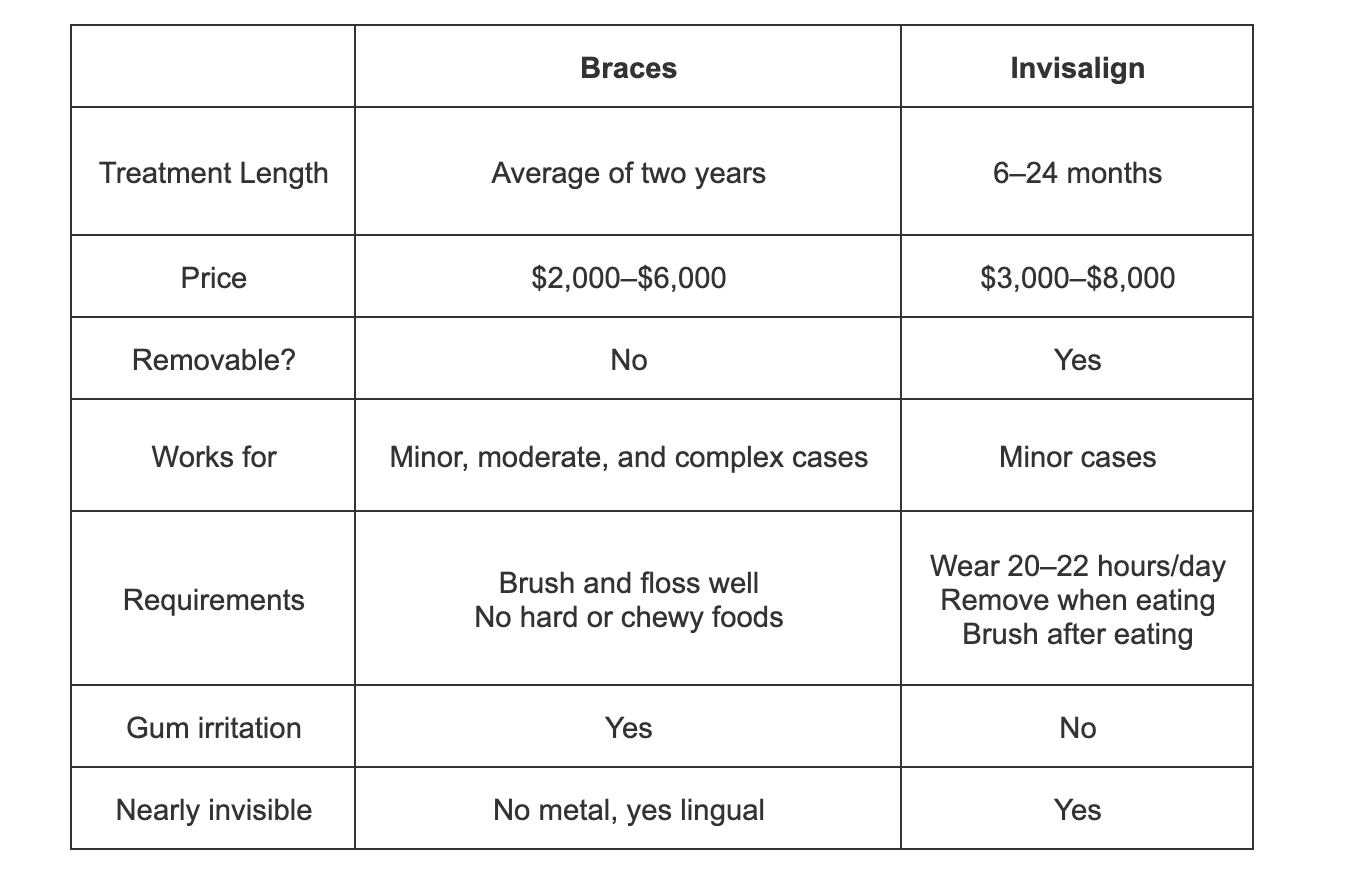
Many people used to only consider traditional braces when considering orthodontic treatment. Clear aligners, more commonly known by the trade name Invisalign, are now a well-liked alternative on the market. Depending on a patient's lifestyle and treatment objectives, one treatment approach may be suggested over another even if they are not always superior to one another.
Let's discuss what Braces and Invisalign are, how they work, similarities and differences between each alternative in terms of visibility, comfort, hygiene, and food and others.
What are Braces?-The Time-Tested Orthodontic Care for Unstoppable Smiles
The first orthodontic treatment method was braces. Researchers have even discovered simple braces on ancient Egyptian mummies, proving that the basic brace design has been present for generations.
Fortunately, braces have improved significantly over time, and research has contributed to making braces a dependable, efficient, and comfortable treatment option for millions of people worldwide who want straight teeth, a healthy bite, and a beautiful smile.
Braces use brackets glued to each tooth and a metal wire to move your teeth safely and effectively. Each bracket is attached to gently shift each tooth into its proper position under the orthodontist's attentive supervision.
There are different kinds of braces; metal, ceramic, and lingual braces can all be used to straighten teeth in different ways. But they can all successfully assist you in developing a beautiful smile and a strong bite!
1. Metal Braces
Braces that use metal brackets and a metal wire to link them are known as metal braces. They are incredibly popular among patients of all ages since they are dependable, convenient, and pleasant.
2. Ceramic Braces
Similar in technology to metal braces, ceramic braces use brackets made of a considerably more discrete clear or tooth-colored resin, which blends in perfectly with teeth and gives them a barely-there appearance.
3. Lingual Braces
Similar to metal and ceramic braces, lingual braces are placed on the inside of the teeth, next to the tongue, rather than being linked to the exterior. The teeth are still moved into their proper locations, but the therapy is considerably less obvious from the outside.
The Benefits of Braces
Utilizes Complex Corrections
A universal treatment that is effective for instances of all severity levels is braces. Braces are more effective than clear aligners because they cling to each tooth directly, giving even the most challenging situations a stunning smile.
Several Alternatives to Consider
While metal braces are the least expensive choice, ceramic and behind-the-teeth (lingual) braces are also available for a more covert appearance. Wearers can accomplish outstanding outcomes without the conventional metal brackets and wires.
Not Removed Easily
Users cannot take out their braces without an orthodontist's assistance, in contrast to Invisalign aligners. However, the permanent attachment calls for less accountability. A mouthpiece does not need to be taken out before eating or left in for at least 20 hours each day. With this basic therapeutic strategy, children, adolescents, and adults may all fare better.
All Beverages are Safe to Drink
Wearers of braces can have tea, coffee, or other liquids throughout the day without having to remove aligners or perhaps stain attachments because braces don't stain and are heat resistant.
What is Invisalign? - The Well Known Brand of Clear Aligner
One brand of clear aligners, an orthodontic tool used to straighten teeth, is Invisalign. Clear aligners, commonly referred to as invisible braces, are medical-grade plastic mouthpieces that are built to order and press on teeth to move them into the proper position. A discrete substitute for conventional metal braces is clear aligners.
Customers should weigh the advantages and disadvantages of Invisalign and conventional braces to decide which is preferable. Consider the advantages and disadvantages of transparent aligners like Invisalign.
The Benefits of Invisalign - Clear Aligners
Appearance
In contrast to traditional metal braces, translucent plastic Invisalign aligners are virtually undetectable from a distance. One of the key reasons why so many individuals prefer transparent aligners to braces is their discrete design.
Comfort
In contrast to braces, which can result in cuts and discomfort, clear aligners fit snugly against teeth. While teeth realignment does cause some discomfort for patients, Invisalign generally reduces pain inside the mouth.
Simpleness of Flossing and Brushing
Users of clear aligners can brush and floss normally after taking off the mouthpiece. No need for the drawn-out and difficult dental care procedure associated with traditional braces.
No Risk with Foods That Are Hard or Chewy
To avoid damage or irritation, those wearing braces should stay away from crunchy, chewy foods like almonds, popcorn, and bagels. However, because wearing aligners requires taking them out before eating, these foods are not necessary to avoid.
Fewer Visits to the Orthodontist
With aligners, some patients won't require as many trips to the orthodontist as they would with braces. Although some online businesses offer clients clear aligners and no orthodontic visits, Invisalign treatments typically call for visits every four to six weeks. This isn't always the greatest option, though. Customers who are receiving braces therapy must visit the office for each adjustment.
Braces v/s Invisalign - Comparison Chart

Braces v/s Invisalign - How are they Similar?
Even though they look and feel different, braces and Invisalign treatments are comparable in many respects. While both must be worn continuously, only the Invisalign trays are removed for meals. Both demand a dedication to adhering to wear, cleaning, and dental health guidelines.
For the correction of crooked teeth, overbites, underbites, and jaw position, Invisalign and braces are both effective therapies. The typical length of treatment with Invisalign or braces is similar at 16 months.
Braces v/s Invisalign - How are they Different?
The method used to move teeth and produce an attractive smile is the fundamental distinction between braces and Invisalign.
In order to reposition the teeth during therapy, braces use sophisticated wires and metal brackets placed within the mouth. In this procedure, elastics are frequently used to realign the teeth.
With Invisalign, teeth are moved using a series of transparent, custom aligning trays that are switched out every week. Although braces may be a superior alternative in some cases for treating orthodontic difficulties, Invisalign's simplicity is unquestionably a positive.
Braces v/s Invisalign - Which Is More Effective?
Braces and aligners both work well. Both fix biting problems in addition to straightening teeth. However, when comparing their efficacy, braces are better able to address more complicated dental issues, whereas aligners work well for repositioning teeth and enhancing their appearance when the tooth motions aren't too complicated.
Braces v/s Invisalign - Which one to use When?
Your orthodontist will be able to advise you on the best course of action, but they'll probably consider the following things first:
- Aligning the teeth
- Bite Issues
- Lifestyle
Complex misalignment and biting issues can be treated more successfully with traditional braces. Aligners can be the best option for you if your tooth alignment problems are not severe.
Braces v/s Invisalign - How Much Does They Cost?
We anticipate that the topic of cost will come up when comparing braces and aligners. For the best idea of cost, you can visit your nearest Local Dental Clinic to discuss your case. It's crucial to remember that not all insurance plans will cover Invisalign because it can occasionally be considered a cosmetic procedure.
Conclusion:
For a beautiful, healthy smile, both braces and Invisalign aligners are fantastic options. Both offer dependable, precise movement of your teeth to enhance your bite, smile, and confidence, while each has unique benefits.
Whatever course of treatment you select, keep in mind that your skilled doctor will utilise both braces and Invisalign aligners. Either device will be used to straighten your teeth and produce the best outcomes under the supervision of the orthodontist you work with for your smile.
Your orthodontist will go through your diagnosis with you at your consultation and suggest the best course of action for your needs. You will start a partnership together that will make you happy for years to come. To discuss more, book your appointment now at your nearest Local Dental Clinic and Keep Smiling Confidently.
Go Back

















